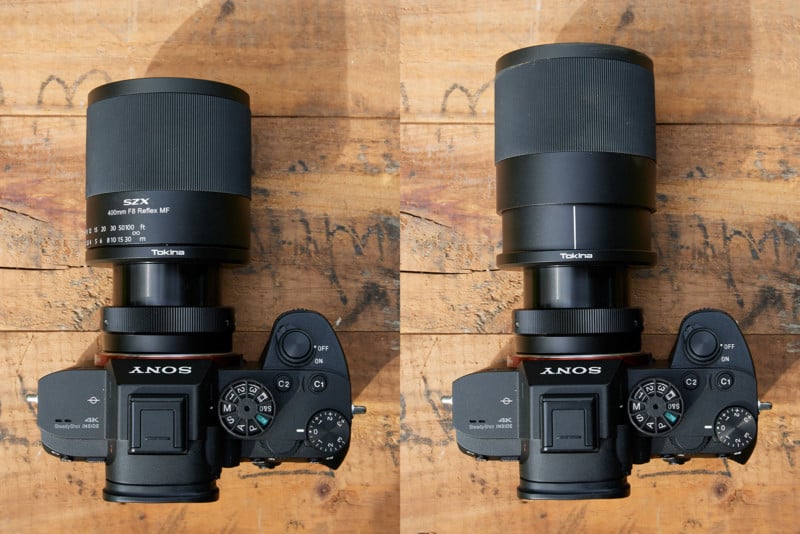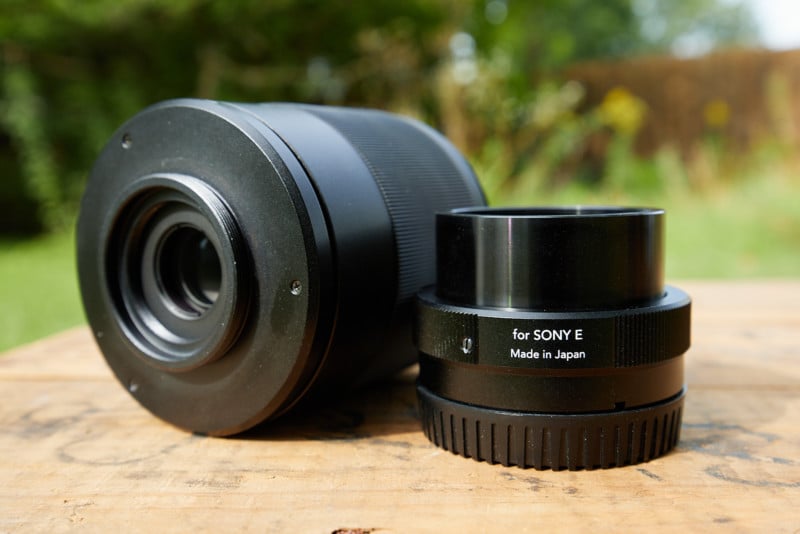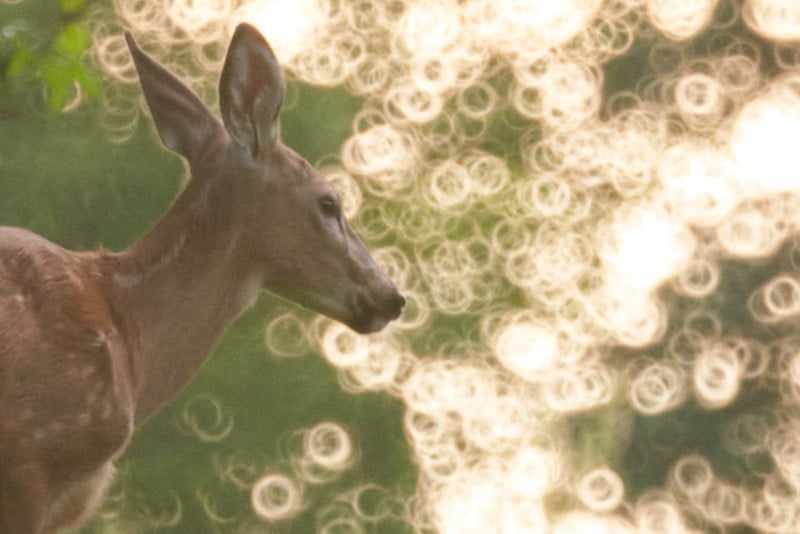
![]()
Remember when lenses had character? Tokina remembers. Last year, it released the SZX 400mm f/8 reflex lens which oozes personality that most modern lenses miss out on — it’s a tiny but mighty telephoto lens.
While Tokina originally announced the lens in July of 2020, it recently also added support for Canon RF and Nikon Z mounts, making it available in just about every major popular lens mount outside of L-mount.
As a preface, the Tokina SZX 400mm f/8 is what’s called a mirror lens or a reflex lens (or if you want to sound like a real nerd: a catadioptric lens). This general design has been around for a very long time, going back to the 1800s when it was first developed for microscopes. With regular photography lenses, the light enters and travels down the optical path right to the camera’s sensor. For reflex lenses, the path is folded by an internal mirror which makes it possible to have long focal lengths contained in a relatively small housing.
Most all of these lenses, including this SZX 400mm, do not have autofocus and are manual focus only. They also all have a fixed aperture. That means that this f/8 lens is only an f/8 lens and cannot be stopped down further without the use of neutral density filters or other external means. Finally, they have a weird-looking front glass element because of the mirror system inside. This round shape that sits in the center of the lens shows up in the out of focus areas of a photo for a distinct look that we’ll see below.
![]()
![]()
Build Quality and Design
Owning a 400mm lens usually comes with limitations on where it would be comfortable to bring along. You wouldn’t necessarily want to casually take it on a dog walk where photography is not the primary focus, for example. Yet, the Tokina SZX 400mm to me does not reach the threshold of being a burden on almost any occasion. It’s quite small — about the size of a standard 24-70mm f/4 lens — and also very lightweight at just 12.5 ounces (354.4 grams). It’s a carry-everywhere type of lens, but it’s also got heavy firepower with that 400mm reach. That’s an exciting combination.
Looking at the full lens, we see a very simple metal construction on the outside. Virtually the entire lens rotates and acts as the focus ring, but there is a wide strip of rubber as well to allow for a better grip. The focus ring twists a very smooth 270 degrees that you’re either going to love or hate. While it allows for gentle, precise movements, it pays for this by being slow to focus greater distances.
For wildlife, I found it to be irksome having to twist so much in order to focus from subjects near to far and back again — I cannot sweep the focus range in a single twist of my left hand while holding the camera steady in the other. As the focus moves from infinity toward the close focus distance of 3.77 feet (1.15 meters), the physical length of the lens also extends out up to around 0.75 inches (1.91 centimeters).

Another point that I think many will agree with me on is that the lens hood design is not good. The metal hood screws right onto the lens’s 67mm filter threads and creates a few problems in doing so. For one, the lens hood cannot be reversed and attached to save room in the bag. Instead, it will need to be wrapped unsecured around the lens. Secondly, when the lens hood is attached, that means the supplied lens cap cannot be clipped on at the same time. Thirdly, one cannot use filters and the lens hood at the same time as they require the same threading.
On a positive note, Tokina designed the SZX 400mm to have interchangeable camera mounts. That’s right: the camera mount end can unscrew off and be replaced with any of the other supported mounts that are sold separately. For this review, I’ve been using the Sony E-mount version. However, if down the line I get into the Canon mirrorless system, I simply purchase the $29 RF mount, swap them out, and the lens comes with me. Mounts are available to be purchased independently for Canon EF and RF, Nikon F and Z, Fujifilm X, Micro Four Thirds, and Sony E.
![]()

Image Quality
Inside, the lens uses six elements in five groups and has multi-layered anti-reflective coatings. For a $250 400mm lens, the image quality ended up exceeding my expectations. I never assumed this lens to be wildly sharp with stellar contrast and clarity, and sure enough, it doesn’t go that far. That said, Tokina SZX 400mm holds up quite well for the cash spent. After some minor tweaking in editing to bring back contrast in photos, it’s hard to complain when that’s all it really needs.
One benefit typical to the reflex lens design is the elimination of chromatic aberrations. While other cheap photo lenses out there typically suffer from heavy color fringing, there is none to be found with this 400mm lens.
![]()
![]()
![]()
As for image sharpness, I felt that was more a matter of attaining accurate focus in the first place. It can be a difficult task to hit critical focus manually with 400mm at f/8. The fact that the lens naturally lacks some clarity also contributes to the difficulty in eyeballing it.
I quickly learned that the best way to ensure sharpness was to use the focus magnifier setting mapped to a custom button on my Sony camera and digitally punch in on the image to adjust focus as I’m firing away on the shutter. It’s not the easiest thing in the world for constantly moving subjects like birds, but it gets the job done with greater accuracy than focus peaking or eyeballing from the full-frame display.
Lastly, we can’t talk about a reflex lens without bringing up one of its defining qualities: the bokeh. Since the lens features a round opaque structure set in the middle, this results in matching donut-shaped bokeh balls in out-of-focus areas of the image.
It’s busy, it’s strange, and it’s pronounced, but it’s also unique and fun and can give photos the extra spark needed to stand out in a positive way. Personally, I love it, but the trick is to really lean into the look and embrace it. If I shoot with the sun to my back and there’s flat lighting in the out of focus areas, it tends to not look flattering. On the other hand, shooting backlit and really trying to find out-of-focus backgrounds and foregrounds with scattered high-contrast light everywhere makes photos shine with a special, original look to them.
![]()
![]()

The Greater the Challenge, the Greater the Reward
This is not an easy lens to use, but that doesn’t mean it’s a bad lens. It’s actually quite fun to be challenged to find scenarios where the photos from this lens will pop because once you do, the results are magical. It’s also extremely handy to keep around since the size and weight means it can be tossed in any bag or left on the camera for whenever the occasion strikes to zoom in.
![]()
![]()
![]()
Are There Alternatives?
For $300, there’s the more expensive Rokinon Reflex 300mm f/6.3 ED UMC CS that can be purchased new for select camera mounts. It’s less focal length but also a fixed f/6.3 rather than f/8 like the Tokina.
Alternatively, since the mirror reflex lens design is more of a historical product in photography these days, there’s always the option to head to eBay and pick up one of the older designs and adapt them to a modern mount where possible. You can find 500mm, 600mm, and even 800mm f/8 reflex lenses out there for relatively cheap.
![]()
![]()
Should You Buy It?
Yes. For $250 and the ability to switch out camera mounts down the line, the Tokina SZX 400mm f/8 Reflex is a creative-use lens that’s worth the cost if you’re up for a fun challenge.

